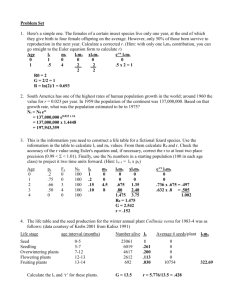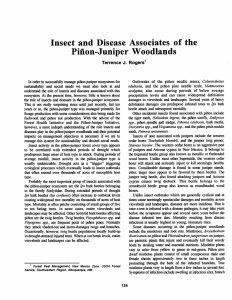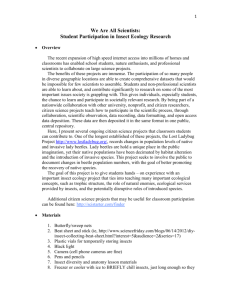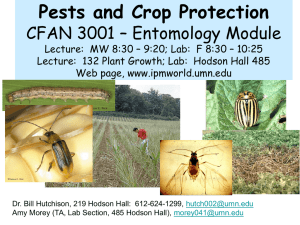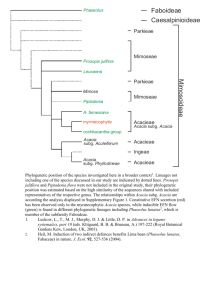Problem Set 2 Life Tables and Demography
advertisement
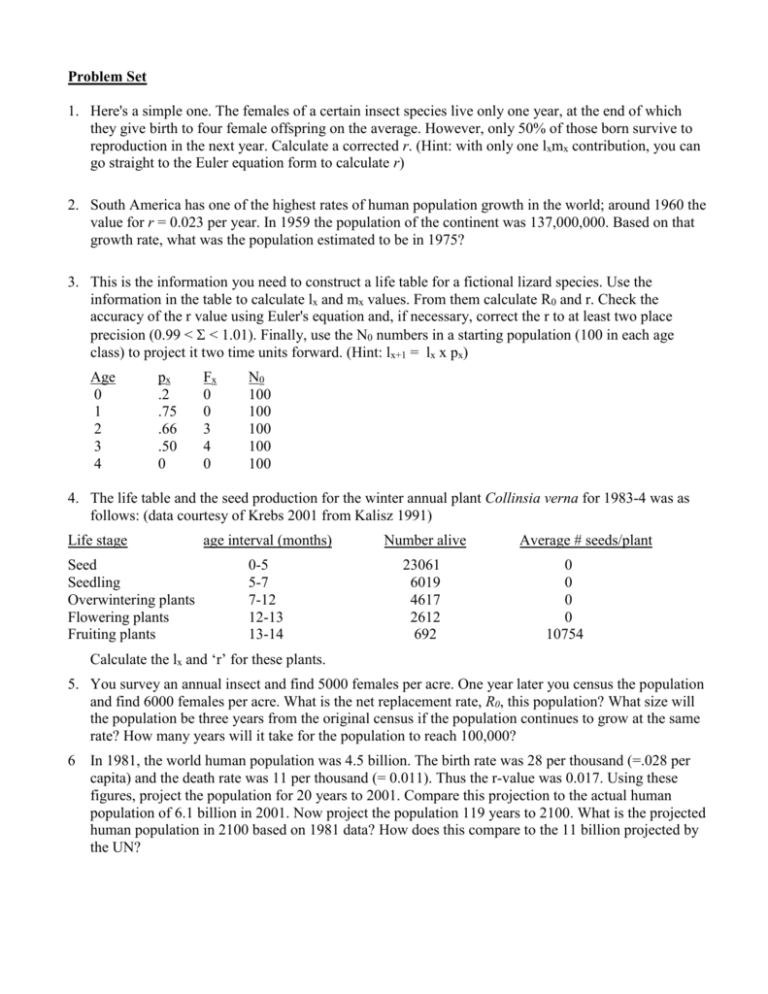
Problem Set 1. Here's a simple one. The females of a certain insect species live only one year, at the end of which they give birth to four female offspring on the average. However, only 50% of those born survive to reproduction in the next year. Calculate a corrected r. (Hint: with only one lxmx contribution, you can go straight to the Euler equation form to calculate r) 2. South America has one of the highest rates of human population growth in the world; around 1960 the value for r = 0.023 per year. In 1959 the population of the continent was 137,000,000. Based on that growth rate, what was the population estimated to be in 1975? 3. This is the information you need to construct a life table for a fictional lizard species. Use the information in the table to calculate lx and mx values. From them calculate R0 and r. Check the accuracy of the r value using Euler's equation and, if necessary, correct the r to at least two place precision (0.99 < < 1.01). Finally, use the N0 numbers in a starting population (100 in each age class) to project it two time units forward. (Hint: lx+1 = lx x px) Age 0 1 2 3 4 px .2 .75 .66 .50 0 Fx 0 0 3 4 0 N0 100 100 100 100 100 4. The life table and the seed production for the winter annual plant Collinsia verna for 1983-4 was as follows: (data courtesy of Krebs 2001 from Kalisz 1991) Life stage Seed Seedling Overwintering plants Flowering plants Fruiting plants age interval (months) Number alive 0-5 5-7 7-12 12-13 13-14 23061 6019 4617 2612 692 Average # seeds/plant 0 0 0 0 10754 Calculate the lx and ‘r’ for these plants. 5. You survey an annual insect and find 5000 females per acre. One year later you census the population and find 6000 females per acre. What is the net replacement rate, R0, this population? What size will the population be three years from the original census if the population continues to grow at the same rate? How many years will it take for the population to reach 100,000? 6 In 1981, the world human population was 4.5 billion. The birth rate was 28 per thousand (=.028 per capita) and the death rate was 11 per thousand (= 0.011). Thus the r-value was 0.017. Using these figures, project the population for 20 years to 2001. Compare this projection to the actual human population of 6.1 billion in 2001. Now project the population 119 years to 2100. What is the projected human population in 2100 based on 1981 data? How does this compare to the 11 billion projected by the UN? 7 What are R0 and the gross reproductive rate for the following population? Age class (x) 0 1 2 3 4 5 l(x) m(x) 1.0 0.8 0.6 0.4 0.2 0 0 1 2.0 2.1 2.6 0 8. For the information in the following life table, calculate the gross and net reproductive rate, and also the intrinsic rate of increase. Age class (x) 0 1 2 3 l(x) m(x) 1.0 0.6 0.3 0 0 2 2 0 9. Draw a survivorship curve for each of two populations of the same species. One cohort is started at high density; the other cohort is started at low density. Mortality in this species shows density dependence. Label axes, provide arbitrary scales, and label your curves. 10. A field survey of bruchid beetles revealed a dense population of the beetle on one species of Acacia tree and very few beetles on a second species of Acacia. Samples of the second Acacia were brought into the laboratory and a cohort of beetle eggs was placed on the leaves, from which the following life table for the beetle was developed: Age class (x) 0 1 2 3 4 5 6 7 l(x) m(x) 1.0 0.9 0.7 0.6 0.4 0.3 0.15 0 0 0 0.1 0.2 0.3 0.1 0.1 --- Does the life table provide any clues about the rarity of the beetle on the second species of Acacia? 11. Here is hypothetical field survey data for a population of pond snails, Helisoma trivolvis. The values collected are S(x), the number of snails from an initial, introduced cohort released in the pond, and b(x), the mean number of egg sacks produced by a snail (they are hermaphroditic). Egg sacks each contain 10 fertilized eggs. Age in years (x) S(x) b(x) 0 1 2 3 500 400 40 0 0.0 0.6 3.5 ---- Complete the life table by calculating l(x), p(x), R0, G and an initial estimate of r. Use Euler’s equation to correct r so that 0.99 < Σe-rx l(x)m(x) < 1.01. 12. The following schedule of births and deaths is for a population that triples each generation. What is the value for m4? Show your calculations! Age class (x) 0 1 2 3 4 5 l(x) 1.0 0.7 0.5 0.4 0.2 0 m(x) 0 2.0 1.8 1.25 ? m4 = ? 13. The giant lobelia, Lobelia deckenii, on Mount Kenya produces on average 250,000 seeds. Average adult survivorship is 0.984 per year. Plants do not begin setting seed until they are ~50 years old. What must the survivorship of seeds be to produce a stable population (λ = 1)? 14. Determine the doubling times for the following human populations (realized instantaneous rates of increase from U.N. data for 1999): Country Realized instantaneous Rate of population increase Ghana 0.029 South Africa 0.016 Canada 0.004 United Kingdom 0.002 Argentina 0.012 Russia -0.005 15. This problem is stolen from Krebs (2001) because it presents an important view of human population growth. If the human population instantly adopted zero population growth (R0 = 1), the population would continue to grow until it reached a stationary age distribution. Keyfitz (1971) showed that such a population would continue to increase by demographic momentum, as follows: Q . be R0 10 ra R0 Where Q = finite rate of population change (1.0 = no change) b = crude birth rate per 1000 persons e = life expectancy at birth in years r = current rate of natural increase per 1000 persons a = average age at first reproduction in years A human population growing at these rates would increase Q times before it reached equilibrium. In 1998 the parameters for the global population were b =28, e = 61, r = 17, a = 25, and R0 = 1.77. If the human population is now ~7 billion, what is the value of Q based on those 1988 parameters, and how large would the population be by the time a stationary age distribution was reached? 16. Both abiotic and biotic factors influence the birth and death rates of populations and species. Choose a species common in this area and make a list of the abiotic and biotic factors that are potentially important in regulating the local population of that species. 17. A population of insects triples every year. Initially there were 40 insects. How many insects would there be after 4 years? Holw many insects would there be after 27 years? (Write the answer to this question as an equation, as well as the solution.) Assume that the habitat of this insect degraded when the population size reached 100, causing a decrease in from 3 to 0.75. How many insects would there be 3 years after this habitat change?
